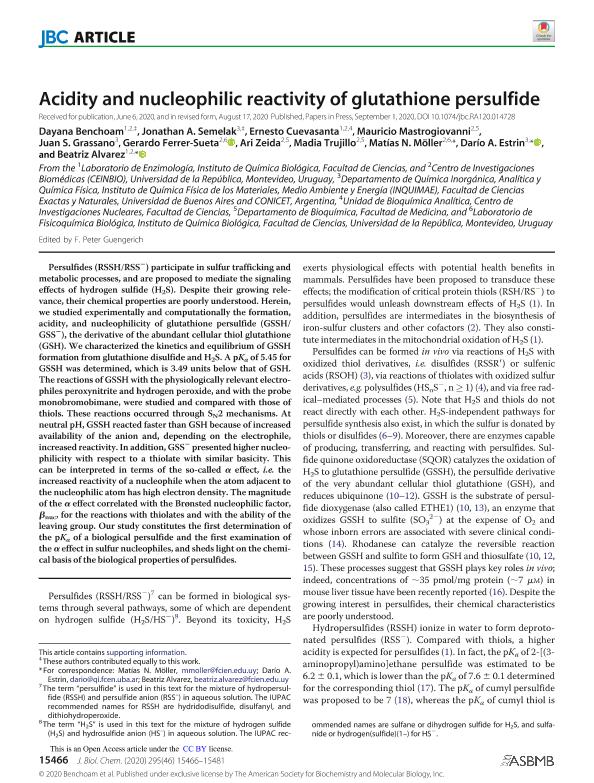Mostrar el registro sencillo del ítem
dc.contributor.author
Benchoam, Dayana
dc.contributor.author
Semelak, Jonathan Alexis

dc.contributor.author
Cuevasanta, Ernesto
dc.contributor.author
Mastrogiovanni, Mauricio
dc.contributor.author
Grassano, Juan S.
dc.contributor.author
Ferrer-Sueta, Gerardo
dc.contributor.author
Zeida Camacho, Ari Fernando

dc.contributor.author
Trujillo, Madia

dc.contributor.author
Möller, Matías N.
dc.contributor.author
Estrin, Dario Ariel

dc.contributor.author
Alvarez, Beatriz

dc.date.available
2021-10-06T19:13:25Z
dc.date.issued
2020-11
dc.identifier.citation
Benchoam, Dayana; Semelak, Jonathan Alexis; Cuevasanta, Ernesto; Mastrogiovanni, Mauricio; Grassano, Juan S.; et al.; Acidity and nucleophilic reactivity of glutathione persulfide; American Society for Biochemistry and Molecular Biology; Journal of Biological Chemistry (online); 295; 46; 11-2020; 15466-15481
dc.identifier.issn
0021-9258
dc.identifier.uri
http://hdl.handle.net/11336/142948
dc.description.abstract
Persulfides (RSSH/RSS2) participate in sulfur trafficking and metabolic processes, and are proposed to mediate the signaling effects of hydrogen sulfide (H2S). Despite their growing relevance, their chemical properties are poorly understood. Herein, we studied experimentally and computationally the formation, acidity, and nucleophilicity of glutathione persulfide (GSSH/ GSS2), the derivative of the abundant cellular thiol glutathione (GSH). We characterized the kinetics and equilibrium of GSSH formation from glutathione disulfide and H2S. A pKa of 5.45 for GSSH was determined, which is 3.49 units below that of GSH. The reactions of GSSH with the physiologically relevant electrophiles peroxynitrite and hydrogen peroxide, and with the probe monobromobimane, were studied and compared with those of thiols. These reactions occurred through SN2 mechanisms. At neutral pH, GSSH reacted faster than GSH because of increased availability of the anion and, depending on the electrophile, increased reactivity. In addition, GSS2 presented higher nucleophilicity with respect to a thiolate with similar basicity. This can be interpreted in terms of the so-called a effect, i.e. the increased reactivity of a nucleophile when the atom adjacent to the nucleophilic atom has high electron density. The magnitude of the a effect correlated with the Brønsted nucleophilic factor, bnuc, for the reactions with thiolates and with the ability of the leaving group. Our study constitutes the first determination of the pKa of a biological persulfide and the first examination of the a effect in sulfur nucleophiles, and sheds light on the chemical basis of the biological properties of persulfides.
dc.format
application/pdf
dc.language.iso
eng
dc.publisher
American Society for Biochemistry and Molecular Biology

dc.rights
info:eu-repo/semantics/openAccess
dc.rights.uri
https://creativecommons.org/licenses/by-nc-sa/2.5/ar/
dc.subject
QM-MM
dc.subject
persulfide
dc.subject.classification
Otras Ciencias Químicas

dc.subject.classification
Ciencias Químicas

dc.subject.classification
CIENCIAS NATURALES Y EXACTAS

dc.title
Acidity and nucleophilic reactivity of glutathione persulfide
dc.type
info:eu-repo/semantics/article
dc.type
info:ar-repo/semantics/artículo
dc.type
info:eu-repo/semantics/publishedVersion
dc.date.updated
2021-04-28T21:02:58Z
dc.journal.volume
295
dc.journal.number
46
dc.journal.pagination
15466-15481
dc.journal.pais
Estados Unidos

dc.journal.ciudad
Bethesda
dc.description.fil
Fil: Benchoam, Dayana. Universidad de la República; Uruguay
dc.description.fil
Fil: Semelak, Jonathan Alexis. Consejo Nacional de Investigaciones Científicas y Técnicas. Oficina de Coordinación Administrativa Ciudad Universitaria. Instituto de Química, Física de los Materiales, Medioambiente y Energía. Universidad de Buenos Aires. Facultad de Ciencias Exactas y Naturales. Instituto de Química, Física de los Materiales, Medioambiente y Energía; Argentina
dc.description.fil
Fil: Cuevasanta, Ernesto. Universidad de la República; Uruguay
dc.description.fil
Fil: Mastrogiovanni, Mauricio. Universidad de la Republica; Uruguay
dc.description.fil
Fil: Grassano, Juan S.. Universidad de Buenos Aires; Argentina
dc.description.fil
Fil: Ferrer-Sueta, Gerardo. Universidad de la Republica; Uruguay
dc.description.fil
Fil: Zeida Camacho, Ari Fernando. Universidad de la Republica; Uruguay
dc.description.fil
Fil: Trujillo, Madia. Universidad de la Republica; Uruguay
dc.description.fil
Fil: Möller, Matías N.. Universidad de la Republica; Uruguay
dc.description.fil
Fil: Estrin, Dario Ariel. Consejo Nacional de Investigaciones Científicas y Técnicas. Oficina de Coordinación Administrativa Ciudad Universitaria. Instituto de Química, Física de los Materiales, Medioambiente y Energía. Universidad de Buenos Aires. Facultad de Ciencias Exactas y Naturales. Instituto de Química, Física de los Materiales, Medioambiente y Energía; Argentina
dc.description.fil
Fil: Alvarez, Beatriz. Universidad de la Republica; Uruguay
dc.journal.title
Journal of Biological Chemistry (online)

dc.relation.alternativeid
info:eu-repo/semantics/altIdentifier/doi/http://dx.doi.org/10.1074/jbc.RA120.014728
dc.relation.alternativeid
info:eu-repo/semantics/altIdentifier/url/https://www.jbc.org/article/S0021-9258(17)50382-8/fulltext
Archivos asociados
